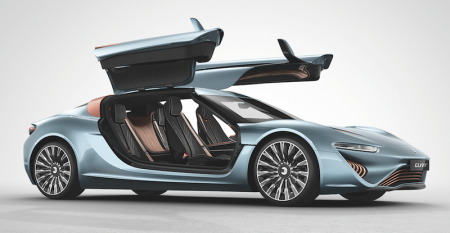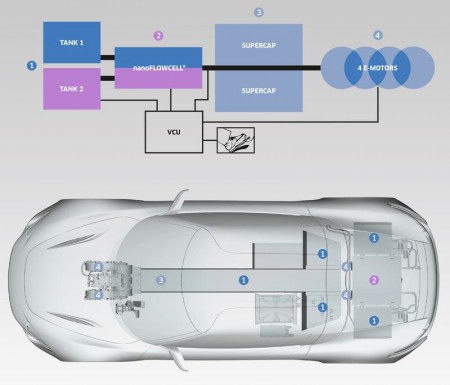Mar
6
A Flow Cell Battery Installed In Prototype Super Car
March 6, 2014 | 22 Comments
Liechtenstein based nanoFLOWCELL AG has built a prototype vehicle equipped with flow cell battery power train. The car, called the QUANT e-Sportslimousine, is on display at the Geneva Motor Show. The firm claims the flow cell battery system supports an electric car driving range of between 400 to 600 km (249 to 373 miles) in the QUANT e-Sportlimousine prototype.
As a road worthy design the first automobile with a nanoFLOWCELL power train aroused great international media interest. This highly anticipated, revolutionary power train technology and energy-storage system could give new momentum to the electric vehicle industry.
Flow batteries or flow cells combine aspects of an electrochemical battery cell with those of a type of fuel cell. The difference is in the electrolyte. Electrolyte fluids in flow cells are usually metallic salts in aqueous solution that can be pumped from tanks through the battery. This forms a kind of battery cell with a cross-flow of electrolyte liquid. The advantage of this system is that the larger the storage tanks for the electrolyte fluid are, the greater the energy capacity. Keep in mind the concentration of an electrolytic solution contributes to the quantity of energy that it contains.
At the heart of the system, a membrane separates the two electrolytic solutions, but allows the electrical charge to pass through and thereby produce power for the drive train.
To charge or discharge nanoFLOWCELL’s flow battery the two different electrolytic solutions are pumped through the appropriate battery cell in which an electrode (anode or cathode) is located. A membrane separates the two electrolyte chambers of different chemistry. At a nominal voltage of 600 V and 50 A nominal current, the system in the lab is achieving continuous output of 30 kW.
According to nanoFLOWCELL, its flow battery has a specific energy of about 5 times that of a Li-ion battery (600 Wh/kg compared to ~120 Wh/kg). The company attributes the performance of the company’s flow battery to the characteristics of its newly-developed and unspecified electrolytic fluids made up of metallic salts at very high concentration.
Offering a bit more information, the company says that a large increase in the number of charge carriers in the electrolyte fluid within the battery significantly increased its performance compared to conventional redox flow-cells (about 5 times the specific energy and several orders of magnitude more specific power).
The company also claims its flow cells can go through 10,000 charging cycles with no noticeable memory effect and suffer almost no self-discharging. That would be over 27 years of service life at a daily charge frequency.
The QUANT e-Sportlimousine prototype carries two 200-liter (53 gallons US) tanks on board, for a total energy capacity of 120 kWh. The prototype’s energy consumption is about 20 kWh/100 km, when driving in the lower load range. Increasing the tank volume of the to 800 liters would be possible, the company says.
The catch is once the electrolytic fluids are discharged, the contents of both tanks must to be replaced. The prototype features a double tank system with dual filler necks, one for each electrolyte, to keep times for the electrolyte liquid replacement to a minimum.
The prototype uses four electric motor units (120 kW continuous, 170 kW peak per unit) for all-wheel drive with torque vectoring and two supercapacitor banks for energy storage. Peak torque per wheel is 2,900 N·m (2,139 lb-ft). The company says acceleration from 0 to 100 km/h is 2.8 seconds.
That where the international media attention motivates. These are supercar numbers.
A central VCU (vehicle control unit) is responsible for controlling the driving and charging currents throughout the entire power train. Supercapacitors provide the peak power to the four drive motors, and also serve as a general energy buffer for the vehicle’s electrical system and storage for regenerative braking energy.
There is more development coming. Last month nanoFLOWCELL AG announced a partnership with Bosch Engineering GmbH to further develop vehicle electronics for the QUANT e-Sportlimousine. The company is planning on producing four drivable prototypes in 2014.
nanoFLOWCELL AG, formerly JUNO Technology Products AG, reforming in late 2013, is a research and development center based in Vaduz, Liechtenstein. Their focus is on the advanced development of drive technology and the classification of flow-cell technology. The firm as Juno showed the earlier NLV Quant prototype at the Geneva Motor Show in 2009.
As noted, the performance is in the supercar range where costs can be as extreme as the performance. It also serves as a platform for development that may well trickle into the mass market. With range in the 300 mile zone and possibly decades of service life the trickle would be welcome, very welcome indeed.
Comments
22 Comments so far




Gives the vehicle an interesting charge by day and travel by night capability. Would be of use to farmers or adventure travelers. Could be taken to low infrastructure areas.
Having read this I believed it was extremely enlightening.
I appreciate you spending some time and energy to put this
informative article together. I once again find myself
personally spending a significant amount of time both reading and posting
comments. But so what, it was still worth it!
Wow, fantastic blog layout! How long have you been blogging for?
you make blogging look easy. The overall look of your web site is wonderful, as well as the content!
My partner and I absolutely love your blog and find most of
your post’s to be just what I’m looking for. can you offer
guest writers to write content in your case? I wouldn’t mind creating a post or elaborating on a number of the subjects you write in relation to here.
Again, awesome web log!
Good day! This is my first visit to your blog! We are a team of volunteers and starting a new project in a
community in the same niche. Your blog provided us beneficial information to work on.
You have done a outstanding job!
If you wish for to grow your know-how just keep visiting this website and be updated with
the newest gossip posted here.
Heya are using WordPress for your blog platform? I’m new to
the blog world but I’m trying to get started and create my
own. Do you need any coding knowledge to make your own blog?
Any help would be greatly appreciated!
リンク
A Flow Cell Battery Installed In Prototype Super Car | New Energy and Fuel
I wonder what concentration of salts is used to create the electrical charge? If it really is isolating components of sea water to create a charge, the possibilities of new energy production are limitless. I want to learn the cost of production for the electrolyte fluid.
The real catch is in the price of electrolytic fluids 😉
In the same time this is the reason why I think this project has any future.
Nobody has any interest in giving free energy, but if Europe, which is poor in fossil fuels has a way to replace them with something that they can sell in the same way as oil, then you have great interest there.
Superb content. Awesome simplicity of your blog and very good visuals. I liked it .. Keep it Admin.
We are a group of volunteers and opening a new scheme in our community. Your website offered us with valuable info to work on. You’ve done a formidable job and our entire community will be thankful to you.
Wow, marvelous weblog layout! How lengthy have you been blogging for? you made blogging glance easy. The overall look of your website is fantastic, as well as the content!
Good day! This is my first visit to your blog!
thx for work
Great information. Lucky me I discovered your site by accident (StumbleUpon).
I have saved it for later!
If some one wishes expert view concerning running a blog afterward I suggest him/her to visit this weblog. Keep up the pleasant
job.
I really appreciate this post. I¡¦ve been looking all over for this! Thank goodness I found it on Bing. You have made my day! Thank you again
It’s going to be end of my day, except before end I am reading this wonderful article to increase my knowledge.
thanks for your helpful instruction. and we want more.
Wow! I made it to the bottom of the post and comments 🙂 This is my first comment, and I read the post through, though it took two days. Lots of links to check out. So much to learn. Thank you for being open and personable and teaching us how it is to be done! I’m hoping my comment posts, as I’m one of those WordPress people.
I like the idea… However, I live in the North-Central part of the United States where the day time temp yesterday was -2F (-19C). While the cell tech sounds interesting, the Bi-Ion electrolytes will not perform nearly so ideally in my environment for almost half of our calendar year.
Solve that riddle, and you can put me down for an AWD sedan and a 4×4 utility vehicle that can carry up to 4’x8′ sheets of plywood at a minimum and can tow my 21′ boat.
I have been absent for a while, but now I remember why I used to love this web site. Thank you, I will try and check back more often. How frequently you update your web site?